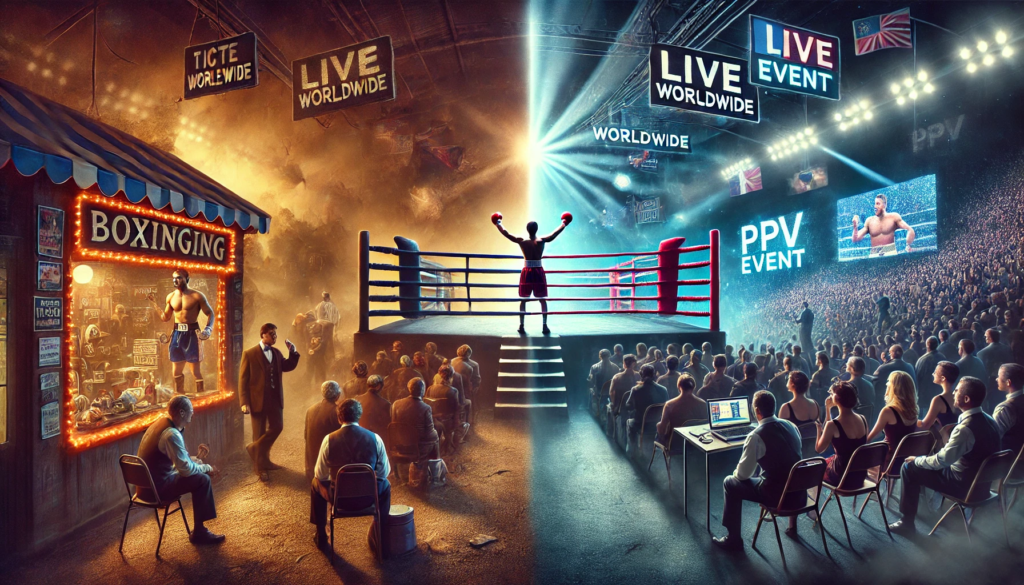The evolution of boxing promotions has taken the sport from small, local venues to global events broadcast to millions. With changes driven by television, pay-per-view, social media, and streaming services, boxing promotions have adapted to new technologies and audience demands. But what does the future hold? Could there come a time when boxing promotions become obsolete, or will they continue to play a key role in the sport? Let’s dive into the transformation of boxing promotions and explore what lies ahead.
The Early Days: Local Arenas and Grassroots Boxing Promotions
Boxing was once a local affair, with fighters building their reputations in small arenas and promoters working tirelessly to sell tickets. In the early days, promotions were largely informal, relying on word of mouth and local newspaper coverage. Fighters like Jack Broughton and John L. Sullivan helped professionalise the sport, but without television or corporate sponsorships, boxing remained relatively small-scale.
The role of a promoter was crucial even then. These individuals organised events, arranged matchups, and ensured fights generated enough revenue to pay the fighters and fund future bouts. Learn more about the role of a boxing promoter in today’s industry.
The Television Boom and Boxing Superstars
The evolution of boxing promotions accelerated in the mid-20th century with the arrival of television. Suddenly, fights could reach national and even global audiences. Boxing legends like Muhammad Ali, Sugar Ray Leonard, and Mike Tyson became household names, and major networks capitalised on the sport’s growing popularity.
Promoters like Don King and Bob Arum saw the potential for massive paydays and built their fighters into global brands. They secured lucrative television contracts and turned championship fights into must-watch spectacles. This era cemented the importance of boxing promotions, as only well-organised events with strong marketing could attract huge audiences and financial backing.
Pay-Per-View and the Birth of the Mega Fight
By the 1990s, the pay-per-view model became the dominant force in boxing promotions. Fights like Tyson vs. Holyfield and Mayweather vs. Pacquiao set revenue records, with promotions focusing on every detail—from dramatic press conferences to pre-fight documentaries designed to build hype.
Promotional companies like Top Rank, Matchroom Boxing (visit Matchroom), and Golden Boy Promotions turned boxing into a billion-dollar industry. Pay-per-view buys, sponsorships, and high-profile fight cards made the sport bigger than ever, with top fighters earning unprecedented purses.
The Digital Age: Social Media, Streaming, and Influencer Boxing
The biggest shift in the evolution of boxing promotions in recent years has been the rise of social media and streaming services. Fighters now build their brands online, engaging directly with fans on Twitter, Instagram, and YouTube. This has changed how fights are marketed and even how they’re made—fighters can call each other out online and create their own hype without needing a traditional promoter.
One of the most controversial figures in modern boxing promotion is Jake Paul. Love him or hate him, he has successfully promoted his own fights using social media, proving that fighters can market themselves without relying on major promotional companies. While some see this as a gimmick, others argue it’s a sign of where boxing is headed.
For more insight into how social media has reshaped boxing, check out Social Media in Boxing.
Will Boxing Promotions Become Obsolete?
With fighters like Jake Paul proving they can promote their own fights, some wonder if traditional boxing promotions will eventually become unnecessary. While social media and streaming platforms give fighters more control, the role of a promoter is still essential for securing venues, handling contracts, and ensuring fights run smoothly.
Promoters also bring credibility and structure to boxing. As much as influencers can generate buzz, there’s still a need for experienced professionals to organise major fight nights and manage fighter careers long-term. Matchroom Boxing, for example, continues to dominate with well-organised events and top-tier talent. Learn more about their role in shaping modern boxing here.
The Impact of Streaming Services: A Double-Edged Sword?
Streaming services like DAZN and Netflix have revolutionised how fans watch boxing, making fights more accessible than ever. However, rising subscription fees and fragmented access to big fights risk alienating traditional boxing fans. In fact, global boxing attendance has dipped for the first time in years, raising concerns about the sport’s future.
For a look at what makes a great boxer beyond titles and records, check out Greatest Boxing Attributes Beyond Titles & Records.
The Future of Boxing Promotions
The evolution of boxing promotions is far from over. As technology advances, we could see:
- Virtual Reality Fight Experiences – Fans watching fights in an immersive VR environment.
- AI-Powered Matchmaking – Algorithms selecting the best fights based on fighter stats and fan demand.
- Global Expansion – Promotions targeting untapped markets in Africa, the Middle East, and Asia.
While self-promotion is on the rise, boxing promotions will continue to play a key role in expanding the sport and ensuring high-quality matchups. The industry will need to adapt, but one thing’s for sure—boxing is here to stay.
Join the Conversation!
What do you think about the evolution of boxing promotions? Will social media and streaming eventually replace traditional promoters, or will they always be essential to the sport? Drop a comment and share your thoughts! And if you want the latest boxing news, fight previews, and expert analysis, visit CMBoxing today!

